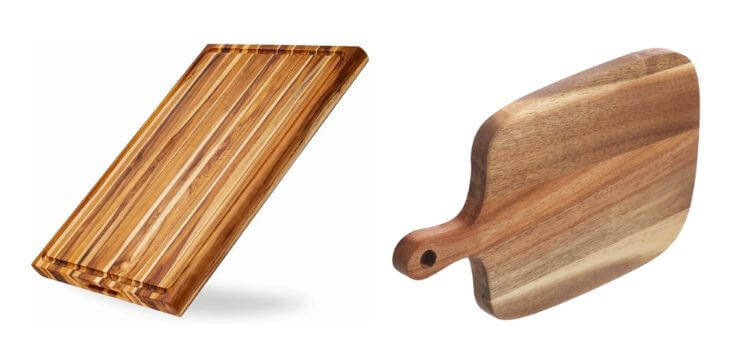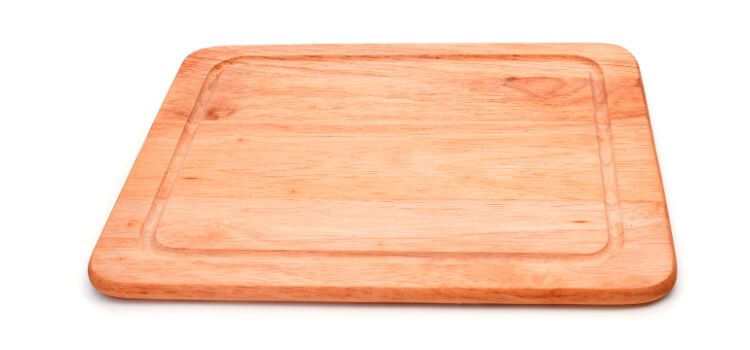As an Amazon Associate, I earn from qualifying purchases

In the vast world of kitchen tools, cutting boards are unsung heroes, quietly supporting both amateur cooks and professional chefs in their culinary adventures. The choice of material for these boards is crucial, as it affects durability, functionality, and even the overall aesthetic of the kitchen.
Among the many options available, poplar wood is often considered for its unique characteristics. But is poplar the right choice for a cutting board? In this article, we’ll delve into the qualities of poplar wood and evaluate its suitability for cutting boards.
Poplar wood is known for being both lightweight and relatively soft compared to other hardwoods. It’s commonly used in furniture making, cabinetry, and certain woodworking projects due to its ease of use and availability. This type of wood is typically pale in color with a straight grain, which can sometimes feature greenish or grayish streaks. Poplar is widely accessible and affordable, making it a popular choice for budget-conscious consumers.
Benefits of Using Poplar for Cutting Boards
- Affordability: Poplar is one of the most cost-effective hardwoods available, making it ideal for those on a budget or looking to invest in multiple cutting boards. Its lower price does not indicate poor quality but rather reflects its accessibility and ease of sourcing.
- Lightweight: The lightweight nature of poplar is a major advantage for users who frequently move their cutting boards for cleaning, storage, or different kitchen tasks. A lighter board is easier to handle, which is especially beneficial for individuals who find heavier woods cumbersome.
- Knife-friendly: Poplar’s softness makes it gentler on knife edges compared to harder woods. This characteristic can help maintain knife sharpness longer, reducing the need for frequent honing and sharpening—an important factor for passionate cooks who value their tools.
Potential Drawbacks
- Softness and Durability: Poplar’s softness can lead to challenges in durability. Its relatively soft structure makes it prone to scratches, dents, and nicks, which can mar the board’s surface over time. This means that poplar cutting boards may not be ideal for those who frequently engage in heavy chopping or use large, sharp knives, as the wear and tear can accumulate quickly.
- Porosity and Moisture Absorption: Poplar is more porous compared to many other hardwoods, which can lead to increased moisture absorption. If not managed properly, this moisture can result in warping or even bacterial growth. A cutting board that absorbs moisture can become a breeding ground for bacteria, posing risks to food safety during preparation.
- Aesthetic Appeal: Poplar has certain aesthetic limitations. Its appearance is usually quite plain, lacking the distinctive grain patterns or rich colors found in woods like walnut or cherry. For individuals who prefer their kitchen tools to have visual appeal, poplar may not meet those expectations.
Comparison with Other Popular Woods
When comparing poplar to other woods commonly used for cutting boards, several key differences emerge. Maple, for example, is renowned for its hardness and resistance to wear, making it a durable choice that withstands heavy use. Its fine grain also prevents excessive moisture absorption, making it a more sanitary option. However, maple can be significantly heavier and more expensive than poplar.
Walnut cutting boards offer a rich, dark aesthetic that many find appealing. While walnut is softer than maple, it is still harder than poplar, providing a good balance between knife-friendliness and durability. However, walnut boards require regular maintenance to maintain their appearance and can be more costly.
Cherry wood cutting boards are known for their warm, reddish hue and moderate hardness. While cherry is softer than both maple and walnut, it is harder than poplar, making it more resistant to damage. Cherry’s aesthetic appeal is a significant draw, but like walnut, it comes at a higher price point.
Tips for Maintaining Poplar Cutting Boards

Proper maintenance is essential to ensure the longevity of a poplar cutting board. Regular cleaning is crucial to prevent bacterial growth. After each use, wash the board with mild soap and warm water, taking care to avoid soaking it. Extended exposure to water can lead to warping, so it’s important to dry the board thoroughly after washing.
Oiling your poplar cutting board is another important step. Applying a food-safe mineral oil or a specialized wood conditioner helps maintain the board’s moisture balance and creates a barrier against water absorption. Regular oiling, performed at least once a month, can significantly extend the life of the board.
To prevent warping and cracking, it’s important to avoid exposing your poplar cutting board to excessive moisture or temperature fluctuations. Store it in a cool, dry place, away from direct sunlight or heat sources. Using cutting board mats or pads can also help protect the board from scratches and other damage during storage.
How to Decide if Poplar is the Right Choice for You
Deciding whether poplar is the right material for your cutting board depends on several factors. Start by evaluating your cooking habits. If you primarily use your board for light cutting tasks and appreciate a lightweight, easy-to-handle board, poplar could be an excellent choice. However, if you frequently perform heavy-duty chopping, you might want to consider a harder wood.
Consider your aesthetic preferences as well. If you’re drawn to elaborate grain patterns and rich colors, poplar’s simpler appearance might not meet your expectations. On the other hand, if you prefer a more understated look, poplar’s pale hues and straight grain could be appealing.
Budget is another significant consideration. Poplar offers an affordable option for those who want a functional cutting board without a hefty price tag. Weigh the cost savings against the potential need for more frequent replacements due to wear and tear.
Conclusion
In conclusion, poplar cutting boards offer an economical and lightweight option for those seeking a basic, functional cutting surface. While they may not boast the same durability or aesthetic appeal as some other hardwoods, they can serve well in kitchens where lighter use is the norm, and budget is a primary concern.
Ultimately, the decision to use poplar for a cutting board comes down to individual priorities and kitchen needs. For those who value affordability and ease of handling, poplar may be a fitting choice. With proper care and maintenance, a poplar cutting board can be a practical and reliable addition to your culinary toolkit.
FAQ
Can you use poplar in a cutting board?
Yes, poplar can be used for cutting boards, but it is softer than other hardwoods. This makes it more susceptible to scratches and dents. While it’s lightweight and affordable, its porosity requires careful maintenance to prevent moisture absorption and bacterial growth.
What wood should not be used for cutting boards?
Avoid using softwoods like pine and cedar for cutting boards. These woods are too soft and porous, making them prone to damage and bacterial contamination. Additionally, their high resin content can impart unwanted flavors and odors to food, making them unsuitable for kitchen use.
What is the best wood for a cutting board?
Maple is often considered the best wood for cutting boards due to its hardness, fine grain, and resistance to bacteria. It provides a durable, sanitary surface for food preparation and complements most kitchen designs with its light color and subtle grain patterns.
What are the disadvantages of poplar wood?
Poplar’s main disadvantages include its softness and high porosity. It scratches and dents more easily than harder woods, and its porous nature can lead to moisture absorption and bacterial growth. Additionally, its plain appearance may not appeal to those seeking a more visually striking wood grain.
As an Amazon Associate, I earn from qualifying purchases
Pingback: Edge Grain vs End Grain Cutting Board